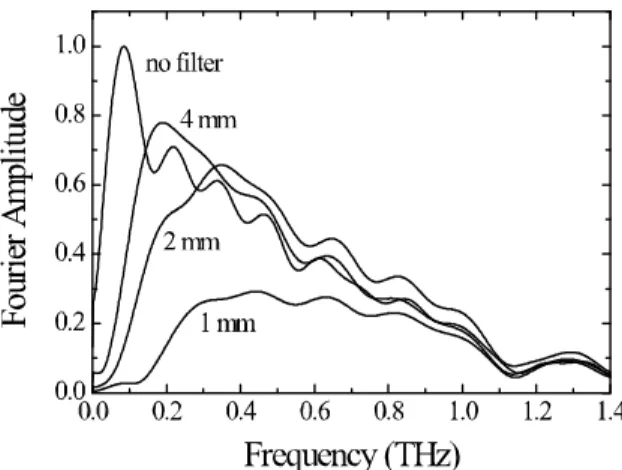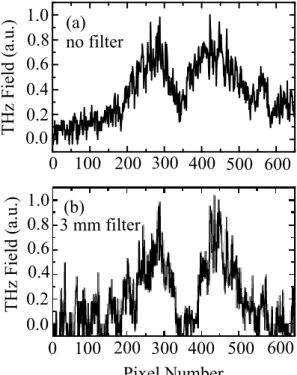Terahertz Real-Time Imaging Using Spatial Filtering
T. Hattori, M. Sakamoto, and R. Rungsawang
Institute of Applied Physics, University of Tsukuba, 305-8573 Japan hattori@bk.tsukuba.ac.jp
Abstract
In order to improve spatial resolution and con- trast in real-time THz imaging using intense THz pulses from a large-aperture photoconductive antenna, amplitudes of low-frequency compo- nents were reduced using a spatial filtering method.
Intense terahertz (THz) electromagnetic pulses emitted from large-aperture photoconductive antennas have been used for real-time acquisition of THz images [1-4]. Since the THz pulses have broad spectrum extending from dc to a few THz, the spatial resolution of the obtained images is limited by the large amplitude of low-frequency components. Although frequency-resolved images obtained by Fourier transformation of a time-scanned series of image data can be used for higher resolution [3], the acquisition of the many images takes a long time, and, therefore, it is not suited for real-time imaging.
In this report, we demonstrated that a spatial filtering method can improve the resolution of the real-time THz images by reducing amplitude of low-frequency components of the THz waves.
In the experiments, a large-aperture semi- insulating GaAs antenna having a 30-mm gap between electrodes was excited by 800-nm, 150-fs amplified optical pulses at a repetition rate of 1 kHz. Intense THz pulses emitted from this antenna were used for real-time imaging using an electro-optic (EO) sampling method and a CCD camera [1-4]. We introduced a spatial filter in the imaging apparatus in order to cut off low- frequency components. Before illuminating the sample, the THz pulses were passed through a spatial filter setup, which was composed of an off-axis parabolic mirror for focusing the THz waves, an aluminum plate having a hole of 1, 2, 3, or 4 mm in diameter, and a collimating off-axis parabolic mirror. The focal length of the parabolic mirrors was 50.8 mm. The aluminum plate was placed on the focal plane. Since the beam waist size of focused THz waves depends almost linearly on the wavelength [3], this setup is expected to work as a high-pass filter. The hole size is expected to correspond to the beam waist
size of the component of the cut-off frequency.
The properties of the spatial filter were studied first. The THz waves transmitted through the spatial filter were focused by a TPX lens of 98-mm focal length, and their temporal waveforms were measured at the focus using a standard EO sampling method. The Fourier amplitude of the waveforms obtained with an aluminum plate having a hole of 4 mm, 2 mm, and 1 mm in diameter and without an aluminum plate are shown in Fig. 1. It is clearly seen that the spatial filters work as high-pass filters and that the smaller the hole size is, the higher is the cut-off frequency. It can be shown that the observed behavior is consistent with the result of the Gaussian beam model [3,5]. The result shows that the cut-off frequency can be tuned by simply changing the hole diameter. It is also noted that the transmittance of high-frequency components is very high.
THz images were obtained using the THz waves passed through the spatial filter. Sample objects were placed at the exit of the spatial filter. The spatial distribution of the THz waves transmitted through the object was imaged on to a ZnTe crystal by the TPX lens, and the THz field profile was measured using an optically heterodyned EO sampling method employing an expanded probe beam and a CCD camera [3].
Fig. 1. Fourier amplitude of THz pulses after spatial filtering using metal plates with a hole of 4 mm , 2 mm, and 1 mm in diameter.
JThH2-5
1242
For the characterization of the spatial resolution, 3-mm lines and spaces of aluminum strips on paper was used as a sample object. THz images obtained with and without an aluminum plate in the spatial filter are shown in Fig. 2. The hole diameter on the aluminum plate used was 3 mm.
The images shown in the figure correspond to the spatial distribution of the THz field and were obtained using the procedure described in a previous paper [3]. The dark area in the center corresponds to an aluminum strip and the bright areas on right and left sides show gaps between strips. It is seen from the figure that the image obtained using a filter, image (a), yields a better contrast than that of image (b), which was obtained without the filter.
Figure 3 shows the signal traces on the horizontal lines in the center of the images of Fig. 2. In image (a), there is a large background in the central area where no transmittance of THz waves is expected. In image (b), on the other hand, very small signals are seen in the central area. This result shows that the background in (a) is due to low-frequency THz waves and its intensity was significantly reduced by the spatial filter.
In conclusion, it was demonstrated that a THz high-pass filter can be constructed using focusing and collimating optics and a metal hole and that it can be incorporated in a real-time THz imaging apparatus using THz pulses to improve the spatial resolution and contrast. The cut-off frequency of the filter can be arbitrarily tuned, and the transmittance of high-frequency components is more than 90%.
References
1) R. Rungsawang, A. Mochiduki, S. Ookuma, and T. Hattori, Jpn. J. Appl. Phys. 44, L288-L291 (2005).
2) R. Rungsawang, K. Tukamoto, and T. Hattori, Jpn. J. Appl. Phys. (2005) in press.
3) T. Hattori, K. Ohta, R. Rungsawang, and K.
Tukamoto, J. Phys. D: Appl. Phys. 37, 770-773 (2004).
4) R. Rungsawang, K. Ohta, K. Tukamoto, and T.
Hattori, J. Phys. D 36, 229-235 (2003).
5) T. Hattori, R. Rungsawang, K. Ohta, and K.
Tukamoto, Jpn. J. Appl. Phys. 41, 5198-5204 (2002).
Keywords: terahertz imaging, real-time imaging, high-pass filter
(a)
(b)
THz Field (a.u.)THz Field (a.u.)
Pixel Number 0
100 200
300 400 500 600 0
100 200
600 500 300 400
3 mm filter(b) (a)
no filter 1.0
0.8
0.6 0.4 0.2 0.0
1.0 0.8 0.6
0.4 0.2 0.0
Fig. 2. THz field images of 3-mm lines and spaces of aluminum strips on paper. The image width corresponds to 27 mm on the object plane. (a) An image obtained without spatial filtering. (b) An image obtained using a 3-mm spatial filter. The THz field amplitude was high only in the central area, where clear shapes are seen. The signal values on the horizontal lines in the center are plotted in Fig. 3.
Fig. 3. THz field profiles of the images shown in Fig. 2.
1243

